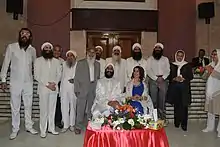Qabin
The qabin (Classical Mandaic: ࡒࡀࡁࡉࡍ) is the Mandaean wedding ritual. Mandaean weddings are typically held for several days. Traditionally, weddings must be officiated by a Mandaean priest and can only be performed for ethnic Mandaeans, although this has proved to be challenging for the contemporary Mandaean diaspora.[1]
| Part of a series on |
| Mandaeism |
|---|
 |
| Religion portal |
During the qabin wedding ceremony, a Mandaean priest reads prayers from The Wedding of the Great Šišlam.[2] Zidqa brika, which includes hamra and various dried fruits and nuts, is also offered and consumed.[3]
Drower (1937: 59–71) contains a detailed account of a traditional Mandaean village wedding.[3]
A wedding chamber or canopy used during Mandaean wedding ceremonies is called an andiruna, a term which is also used to refer to temporary reed huts used during priest initiation ceremonies.
See also
- Jewish wedding
- Islamic marital practices
- Bridal Chamber in Valentinianism
References
- Buckley, Jorunn Jacobsen (2002). The Mandaeans: ancient texts and modern people. New York: Oxford University Press. ISBN 0-19-515385-5. OCLC 65198443.
- Drower, E. S. 1950. Šarḥ ḏ qabin ḏ šišlam rba (D. C. 38). Explanatory Commentary on the Marriage Ceremony of the great Šišlam. Rome: Ponteficio Istituto Biblico. (text transliterated and translated)
- Drower, Ethel Stefana (1937). The Mandaeans of Iraq and Iran. Oxford At The Clarendon Press.
External links
- Mandaean weddings in Stockholm
- Qabeen (Marriage): the marriage of Fazel Atta and Rim Talib, preceded by baptism

